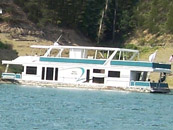So, you want to go boating, but you just can’t live without your TV? Sure, you can buy a 12-volt television, but they’re tiny—and expensive, too. And stretching an extension cord’s kinda out of the question—what can you do? Invest a few bucks in a power inverter to convert your boat batteries’ 12-volt current into electricity your TV can use.
How It Works
A power inverter multiplies 12-volt battery voltage ten times (12X10=120), and modifies the direct current (DC) from the battery(ies) into the alternating current (AC) that electrical devices—like TVs—need to function.
Ratings
Power inverters are rated by their output in watts, and are available from the ultra-compact 50-watt pocket inverters that plug into a 12-volt receptacle (cigarette lighter adaptor), to permanently installed 4000-watt units that are used in conjunction with an on-board generator and/or shore power (electricity from a dockside source).
Upside
With a power inverter, you can enjoy the conveniences of many of your home’s electrical appliances on your boat. On a smaller boat, you can easily watch TV, plug in your computer, or charge a cell phone, while larger boats might use an inverter to zap a sandwich in the microwave oven.
Power inverters are small, relatively inexpensive, and unlike a generator, an inverter is quiet.
Downside
The amount of electricity coming out of a power inverter is directly related to how much electricity is going into it—your power inverter’s output is limited to the strength of your boat’s batteries. You can only operate your electrical devices for a finite period of time before you’ll need to recharge the batteries on the boat.
